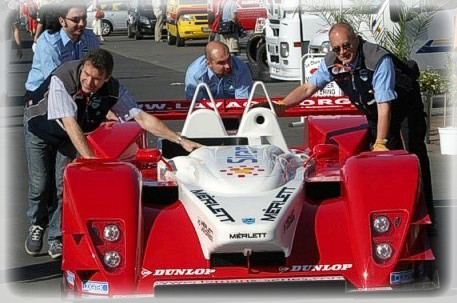|
 While sports car racing is as old as car racing in general, and while sports cars always competed with formula cars to be the peak of motor sports, it has been the World Championship of Makes in the 1960', and right into the late 1970' which eventually marked the start of modern sports car racing. Endurance races like the 24 Hours of Le Mans (in which Giovanni Lavaggi has participated 7 times), the 24 Hours of Daytona (which Giovanni Lavaggi has won 1995) races like the 1,000 KM of Monza (which Giovanni Lavaggi has won 2001), and events such as the "Targa FLorio" have created the myth of sports cars which needs no further explication.
While sports car racing is as old as car racing in general, and while sports cars always competed with formula cars to be the peak of motor sports, it has been the World Championship of Makes in the 1960', and right into the late 1970' which eventually marked the start of modern sports car racing. Endurance races like the 24 Hours of Le Mans (in which Giovanni Lavaggi has participated 7 times), the 24 Hours of Daytona (which Giovanni Lavaggi has won 1995) races like the 1,000 KM of Monza (which Giovanni Lavaggi has won 2001), and events such as the "Targa FLorio" have created the myth of sports cars which needs no further explication.
 Sports prototypes have been the protagonists in this kind of racing. The memory of heroic battles is still alive among race fanatics, names like the Ford GT 40, the Porsche 917 "long tail", the Ferrari 512, the Alfa 33 and others recall these glorious times. Sports prototypes are cars designed and built to race (while GT cars are street car derivates), and these sports prototypes have given the opportunity to car makers to create their high class profile in championships called "World Championship of Makes". Together with the big ones in the car business, smaller enterprises such as Lotus, Lola, Matra and Ferrari (yes, as well Ferrari has participated in sports prototype racing!) have played major roles. Nowadays it is the Audi-Volkswagen group which has chosen this scenery to promote their brands, winning the last 5 editions of the 24 Hours of Le Mans with either Audi or Bentley branded cars.
Sports prototypes have been the protagonists in this kind of racing. The memory of heroic battles is still alive among race fanatics, names like the Ford GT 40, the Porsche 917 "long tail", the Ferrari 512, the Alfa 33 and others recall these glorious times. Sports prototypes are cars designed and built to race (while GT cars are street car derivates), and these sports prototypes have given the opportunity to car makers to create their high class profile in championships called "World Championship of Makes". Together with the big ones in the car business, smaller enterprises such as Lotus, Lola, Matra and Ferrari (yes, as well Ferrari has participated in sports prototype racing!) have played major roles. Nowadays it is the Audi-Volkswagen group which has chosen this scenery to promote their brands, winning the last 5 editions of the 24 Hours of Le Mans with either Audi or Bentley branded cars.
Looking back into history, 1982 to 1992 have been transition years; it was the World Endurance Championship (later called the World Sports Prototype Championship) in which closed prototypes fought for the honours although the habitual format of 1,000-KM races was abandoned towards the end of that period. Porsche, Jaguar, Mazda, BMW, Nissan, Toyota and Peugeot were sporting their colours. Then, 1994, we saw the rebirth of open sports prototype cars at the 24 Hours of Le Mans. while the European championship INTERSERIE featured this category since the year before. 1995, an open sports prototype was up to win the 24 Hours of Daytona, and the American way of sports car racing, a mix of sprints and endurance events, was dominated by that category since then once again. The revival of the classic format of 1,000-KM races in Europe followed soon. It was on the famous circuit of Monza, where sports prototypes and GT's met again in 1997 for the first time, continuing to write the history of the 1,000-KM races.
Since the year 2000, cars and teams which usually only compete against each other at the "24 Hours of Le Mans", meet for regular championship showdowns at the race tracks, and these 1,000-KM races reunite sports prototypes and GT cars, as it has been in the past.
Without any doubt, Sports prototypes are fascinating the enthusiasts who are closely following the motor racing events. This fascination comes from the aggressive and powerful look. Finally, these cars remind you the day-to day street going cars, because opposite to the formula cars which run open wheels, sports prototypes display covered wheels, headlights and two seats.
Nowadays, this championship is named in Europe the "Le Mans Series", by that name referring to it's most important base and it's indisputable flagship: the 24 Hours of Le Mans. The series are offering legendary 1,000-KM races on prestigious circuits such as Monza, Donington, the Nürburgring and Spa, and is going beyond any best expectations.
|

